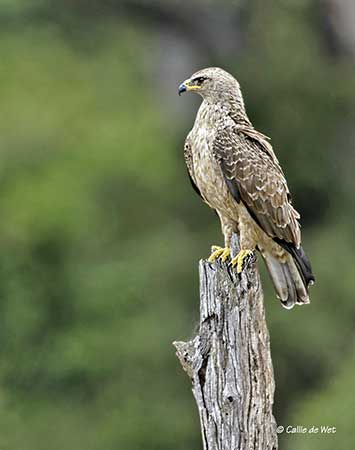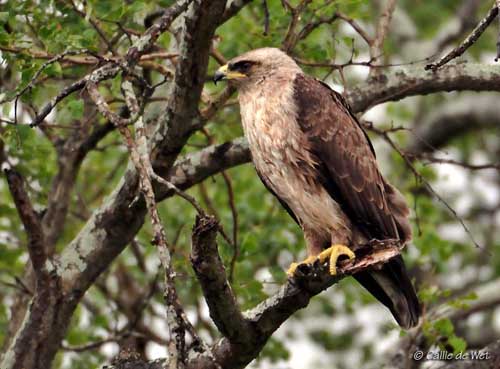
Fr : Aigle de Wahlberg
Ang : Wahlberg’s Eagle
All : Silberadler
Esp : Águila de Wahlberg
Ita : Aquila di Wahlberg
Nd : Wahlbergs Arend
Sd : Wahlbergs örn
Photographers:
Didier Buysse
Vision d’Oiseaux
Callie de Wet
GALLERY
Text by Nicole Bouglouan
Sources:
HANDBOOK OF THE BIRDS OF THE WORLD Vol 2 by Josep del Hoyo-Andrew Elliot-Jordi Sargatal - Lynx Edicions - ISBN: 8487334156
BIRDS OF PREY OF AFRICA AND ITS ISLANDS by Alan and Meg Kemp - Struik Publishers - ISBN: 1770073698
RAPTORS OF THE WORLD by James Ferguson-Lees et David Christie - Helm Identification Guides – ISBN: 0713680261
BIRDS OF AFRICA SOUTH OF THE SAHARA by Ian Sinclair and Peter Ryan - Princeton University Press Princeton and Oxford - ISBN: 0691118159
BIRDS OF EAST AFRICA vol 1 by C.A.W. Guggisberg – Mount Kenya Sundries Ltd. – ISBN: 9966889051
ROBERTS BIRDS OF SOUTH AFRICA by G. R. Mc Lachlan and R. Liversidge – The Trustees of the John Voelcker Bird Book Fund – ISBN: 0620031182
Biodiversity Explorer – The Web of Life in Southern Africa
Global Raptor Information Network - Working to Conserve Birds of Prey in nature
Roberts Online – Birds of Southern Africa
Kruger Park Birding- Eagles and Hawk - Eagles - Birding Raptor Guide
Year-round movements of a Wahlberg’s Eagle tracked by satellite

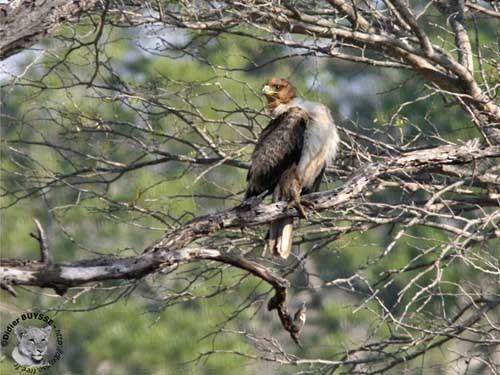
Wahlberg’s Eagle
Hieraaetus wahlbergi
Accipitriformes Order – Accipitridae Family
INTRODUCTION:
The Wahlberg’s Eagle is a fairly small eagle with long, narrow wings and long, squared tail. There are three main forms of plumages, with dark, buffy and pale forms, but other combinations can be seen, including a dark-headed form.
It is one of the most common eagles in Sub-Saharan Africa, and an intra-African migrant. It frequents mainly wooded savannas and woodlands, avoiding dense forest and arid regions. It feeds typically on small prey including mammals, birds, reptiles and amphibians. It hunts from perch or stoops on prey from the air.
The population is currently stable, in spite of human disturbances and woodland clearance.
DESCRIPTION OF THE BIRD:
Biometrics:
Length: 53-61 cm
Wingspan: 130-146 cm
Weight: M: 437-845 g – F: 670-1400 g
The Wahlberg’s Eagle is polymorphic.
The dark morph is the commonest form. It is dark brown overall. The upperwing coverts are edged paler brown, whereas the flight feathers are dark brown. On the underwing, the flight feathers are paler grey-brown with narrow, darker brown barring. The undertail is grey-brown and narrowly barred blackish.
The head is dark brown, and we can see a nuchal crest, sometimes flattened.
The bill is black with yellow cere. The eyes are brown. The bare feet are yellow with black talons, whereas the legs are feathered dark brown.
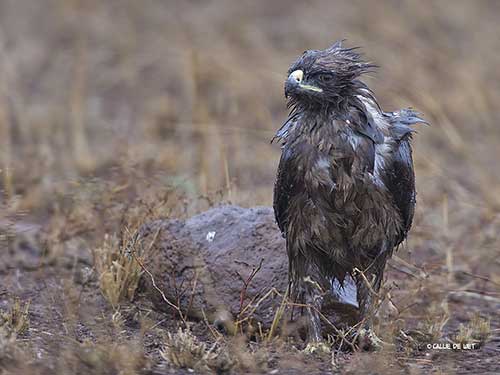
The intermediate morph is similar to the previous but the head is often darker than the body. Flight feathers and tail are dark brown, whereas body and wing-coverts are paler brown or buffy. On the underwing, secondaries and primaries show broad blackish tips.
Some eagles may have white fringes to body feathers, or whitish breast, belly and vent.
The pale morph is the rarest. Head and neck are mainly creamy-white with blackish streaks on crown and around the eyes. Rest of upperparts is dark grey-brown with broad whitish edges to feathers. Underparts and underwing-coverts are creamy-white with variable dark brown spotting or streaking. Flight feathers and tail are dark.
There is also a dark-headed form.
Male and female have similar plumage, but the female is larger and heavier than the male.
The juvenile is indistinguishable from adults of respective morphs, but it has more conspicuous pale fringes to back feathers and upperwing-coverts. The crest is less visible.
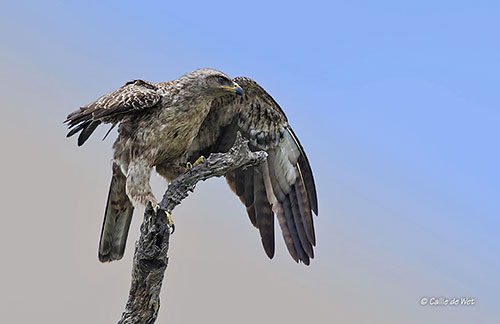
The Wahlberg’s Eagle is often confused with other raptors such as Lesser Spotted Eagle, Booted Eagle, Brown Snake-Eagle and Black Kite.
RANGE:
The Wahlberg’s Eagle is found in W Africa, from S Mauritania and Senegambia, E to Sudan, Eritrea and Ethiopia, S through E Africa to Botswana and N and E South Africa, and W to Angola and N and C Namibia.
It is mostly non-breeding in the northern part of the range, where it is migrant or nomadic.
HABITAT:
The Wahlberg’s Eagle frequents woodlands and wooded savannas of Sub-Saharan Africa. It usually avoids deep forest and open arid and mountainous areas, preferring alternating open grassland and woodland.
This species is usually recorded from sea-level up to 1800 metres of elevation, but locally higher, up to 2800 metres in Ethiopia.
CALLS AND SONGS: SOUNDS BY XENO-CANTO
The Wahlberg’s Eagle is mostly vocal during the breeding season. It gives a rapidly repeated yelping at nest as greeting “kyip-kyip-kyip”. The display call is a mournful whistle “quieee-aow” given both perched and in flight.
BEHAVIOUR IN THE WILD:
The Wahlberg’s Eagle feeds mainly on small mammals (up to size of hare), reptiles (lizards and some snakes), birds (ranging from larks to guineafowls), amphibians, large insects (beetles and grasshoppers) and termites.
The insects are taken around grass fires but usually, it hunts from exposed or concealed perch in tree. However, more often, it soars and glides in the air, up to 25 metres above the ground. Once the prey is located, it makes a fast stoop or a slow parachute descent. It “hangs” over the prey and loses height gradually before the final fast dive onto its victim. Birds and bats are sometimes taken in flight. It also steals food from the Long-crested Eagle.
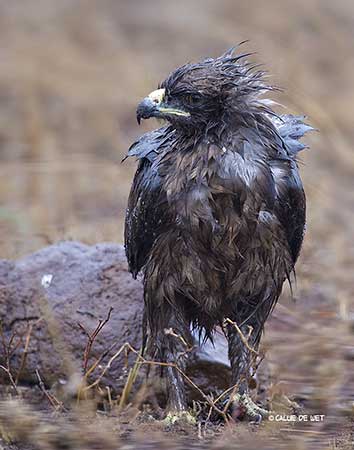
The Wahlberg’s Eagle is monogamous with strong, long-term pair bonds. It performs aerial displays while calling loudly. The birds circle high in the air, soaring and calling. They also perform undulating sky-dance, and both mates typically grasp their talons in flight.
It breeds during the wet season. It is solitary nester and very territorial. Aggressive encounters may occur, even in flight.
The Wahlberg’s Eagle is a regular trans-equatorial, intra-African migrant. They probably winter in savannas from N Nigeria to Sudan. Some birds, possibly juveniles, remain south of Equator, as far as Zimbabwe.
They migrate in flocks and the migration is related to rainfall.
The Wahlberg’s Eagle is very distinctive in flight, especially when soaring on long, rectangular wings with square tips and the long, square tail usually held closed. It glides on folded wings, and fans the tail when seeking lift in thermals.
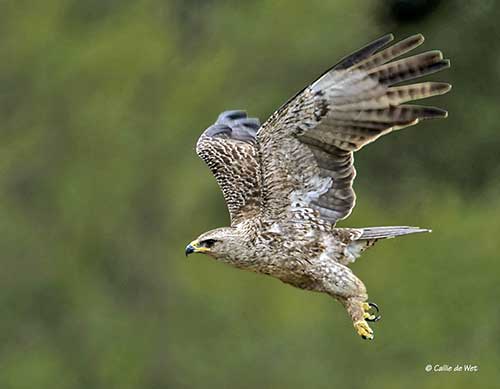
REPRODUCTION OF THIS SPECIES:
The breeding season takes place between September and February, and may vary according to the range (July-November in E Africa).
The nest-site is often in valley along a dry river-course. The small nest is placed in a fork below the canopy of tall tree such as baobab, acacia or eucalyptus.
Both adults build a platform with sticks, lined with green leaves, between 5 and 22 metres above the ground. It is often reused in several following years.
The female lays one, rarely two white eggs with reddish and brown markings. She incubates during 43-46 days, during which she is fed by the male. It may relieve her for short periods. At hatching, the chicks have dark to pale brown down, according to the plumage morph. They are fed by the female with the prey brought by the male. If there are two chicks, the smaller is killed by the elder one. It fledges between 62 and 80 days after hatching, usually 70-77 days. This species produces a single brood per year.
PROTECTION / THREATS / STATUS:
The Wahlberg’s Eagle is one of the most common eagles in Sub-Saharan Africa. Some populations are vulnerable to habitat changes and poisoning, but they have not declined in decades.
The global population was estimated to number 100,000 individuals in 1990s. In South Africa, the estimate is 9,000 pairs, with high densities in Kruger National Park and Sabi Sand Reserve.
The Wahlberg’s Eagle is currently evaluated as Least Concern.
